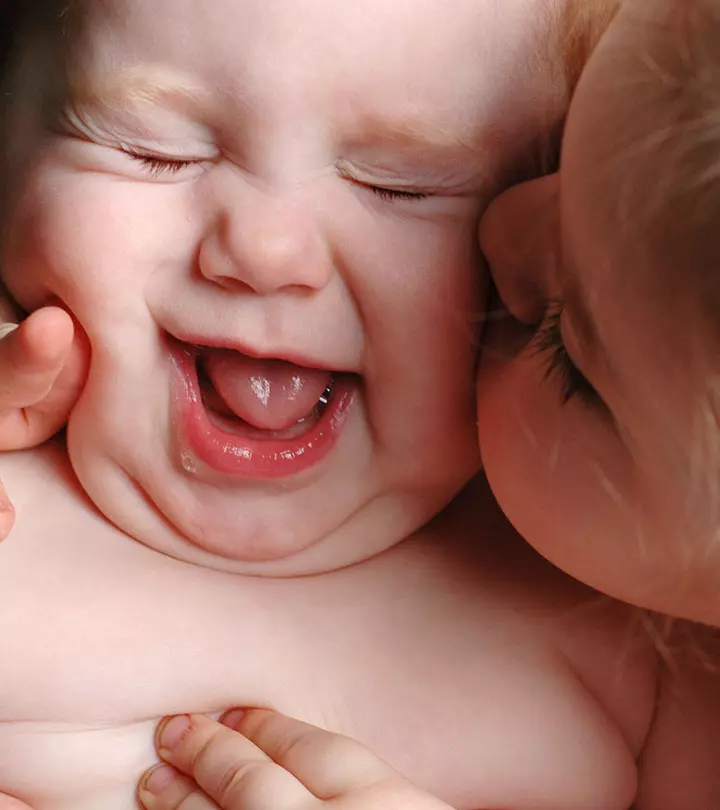

Image: Shutterstock
When it comes to labor and childbirth, many people think of it as a simple process where the expecting mother pushes and pops the baby. This is partly because the depiction of childbirth in media, especially TV and movies, has always been to fit the narration and not for informative purposes. However, labor is more than this and has multiple stages of development. Labor can last anywhere from 8 to 14 hours and can vary from person to person. The whole process of labor can be subdivided into three clear stages. The first stage starts with the onset of labor and finishes with complete cervical dilation. The second stage involves the delivery of the baby. And finally, the third stage is the pushing out of the placenta (1).

The removal of the placenta after delivering the baby is a very important stage of labor. In this stage, there is a high risk of postpartum hemorrhage which can be life-threatening to the mother. This calls for close monitoring and active management of this third and final stage during childbirth (2). It’s also important for the expectant mother to better understand how labor works so that she is not caught totally unawares during labor and starts panicking. Keeping this in mind, let’s understand this lesser-known third stage of labor in more detail:
What Exactly Does The Third Stage Of Labor Involve?
Image: Shutterstock
To understand the third stage of labor, we have to first understand what is the role of the placenta. The placenta is a temporary organ that forms during pregnancy. It is the lifeline for the fetus inside the mother’s womb— it helps in respiration, delivers the essential nutrients, takes care of excretion needs, and many more (3). This multifunctional organ acts as a guardian angel to the human fetus for nine months. So much so that many cultures regard it as holy and give it a proper burial after its removal. Once the baby is delivered, the placenta, having served its purpose, is removed from the body.
Childbirth is often thought of as the end of labor, when in fact the actual end is reached only after the removal of the placenta. Pushing out the placenta is similar to pushing out the baby albeit with lesser pain. After the baby comes out, the uterus again contracts to enable the process of bringing out the placenta. Mostly, it happens without much effort, but in case of any difficulty, the mother is asked to push a little. .
How Long Does It Usually Last?
Image: Shutterstock
This third and final stage of labor is the shortest of the three stages and usually takes about 5 to 30 minutes. A period of more than 30 minutes is linked with postpartum hemorrhage and might lead to the retained placenta where the placenta doesn’t come out naturally. Medical intervention is a must in such situations (1).
Does The Third Stage Of Labor Hurt?
Image: Shutterstock
Pain is subjective, but on average, it is safe to say that it does not hurt as much as the actual delivery of your child. Rather than painful, it can be a stingy experience. Therefore, you cannot describe it as an enjoyable one. The biggest concern here is to bring the placenta out as cautiously as possible. Care providers must make sure that the process is spontaneous and effortless to avoid postpartum bleeding or hurting the lady parts. The mother is asked to focus on the baby as this helps distract her while the process is on. The placenta leaves a large wound in its place that takes 4-6 weeks to heal (1). Due to the risks involved in the final minutes when the placenta is removed, the whole procedure should be carefully and actively managed by the medical attendees present.
Uterine Massage After the Third Stage Of Labor: What To Expect?
Image: Shutterstock
Aren’t massages supposed to be a feel-good factor? Yes, but sadly not this one. Here comes the painful part, though an essential and unavoidable one. The uterine massage is done to make your uterus contract and bring it back to its actual size. It might hurt, and you may feel like totally skipping it, but it has its advantages. Some women will have to undergo it only for the first few hours, while others may have to go through it for longer. The uterine massage is essential to prevent hemorrhage. Lack of proper uterus contractions leads to heavy bleeding and, in some cases, even mortality of the mother. It also helps in getting rid of blood clots, if there are any inside. On the other hand, too much pressure should be avoided as it can be harmful. It is also termed as fundal massage (4).
What’s Next?
Image: Shutterstock
At last, after passing all three stages successfully, the mother gets to celebrate the arrival of her tiny human into this world. Both mother and baby get to spend time with each other. Their emotional bond begins to form through what is known as skin-to-skin contact or kangaroo care for the first few hours. This contact allows the baby to experience the mother’s first touch and enables breastfeeding in that hour, and everyone knows how beneficial that is for the baby. All mamas love this time, and that’s why they should never be separated from their baby in the initial hours after delivery unless there is a medical emergency. Also, after a few minutes, the umbilical cord is cut.
Just like the other two stages of labor, the third stage is also an important one. It involves its own sets of risks and so calls for expertise in being handled. Make sure that the final stage of labor is well managed and attended to. Knowing all the stages of labor will prepare expecting mothers in being ready for the whole affair. They will also be better prepared in communicating with the medical personnel present during labor. What are your thoughts on this? Let us know in the comments below!
References
- Stages Of Labor
https://www.ncbi.nlm.nih.gov/books/NBK544290/ - Active Management Of The Third Stage Of Labor: A Brief Overview Of Key Issues
https://www.ncbi.nlm.nih.gov/pmc/articles/PMC6127474/ - The Placenta: A Multifaceted
Transient Organ - Uterine Massage For Preventing Postpartum Haemorrhage
https://pubmed.ncbi.nlm.nih.gov/23818022/
Community Experiences
Join the conversation and become a part of our nurturing community! Share your stories, experiences, and insights to connect with fellow parents.

















